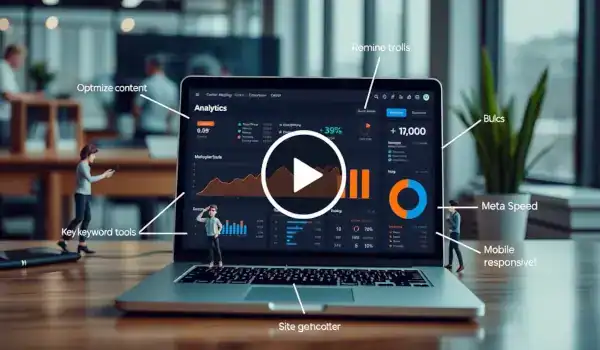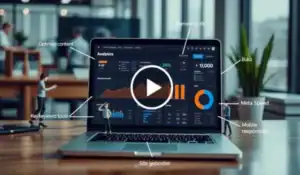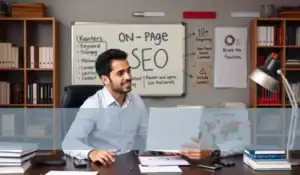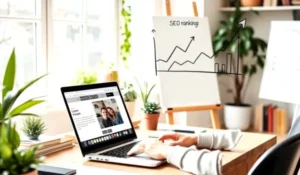Top 10 On-page SEO techniques to boost website traffic fast, getting your website to rank on Google isn’t magic, it’s a strategy. If you’re wondering how to rank higher on search engines like Google, then mastering On-Page SEO is a must. Today, we’re going step by step through 10 practical, proven on-page SEO techniques that can boost your rankings and drive more organic traffic.
What is On-Page SEO?
On-page SEO (or on-site SEO) refers to the optimization of individual web pages so they rank higher in search engine results and attract more relevant traffic. Think of your website as a library. Each page is a book. On-page SEO ensures that each “book” is easy for Google to read, understand, and recommend to users searching for similar content.
Why Is On-Page SEO Important in 2025?
Google’s algorithm is constantly evolving. But one thing remains consistent: well-optimized pages rank better and deliver better user experiences.
Benefits of on-page SEO include:
- Higher Google rankings
- Increased organic traffic
- More conversions and leads
10 On-Page SEO Tricks That Work Like Magic (But Are 100% Real)
1. Craft Magnetic, Keyword-Rich Titles
Your title tag is the first thing both Google and your users see. It’s like a billboard for your page.
Best Practices:
- Put your main keyword at the beginning of your title.
- Keep it clear, click-worthy, and under 60 characters.
Example:
- “Welcome to Our Blog”
- “SEO Tips for Beginners – Rank #1 on Google”
This small tweak can massively increase your click-through rate (CTR).
Use Proper Heading Tags: H1, H2, H3
Google uses your headings to understand the structure of your content.
Think of it like this:
- H1 – Book Title (Use only one per page)
- H2 – Chapters
- H3 – Subsections or Bullet Points
Using headings properly:
Boosts SEO
- Enhances readability
- Helps screen readers and accessibility tools
Tip: Always include keywords naturally in H2 and H3 tags too.
Build Monster Internal Linking
Internal links connect one page of your site to another, and they are SEO gold.
Why it works:
- Helps Google crawl your site better
- Keeps users on your site longer
- Spreads “link juice” to other important pages
Example:
Instead of saying “click here,” say “check out our complete on-page SEO checklist.”
Bonus Tip: Link newer blog posts to older ones — and vice versa — to revive older content!
Create Clean, Keyword-Friendly URLs
Your URLs should be simple, readable, and keyword-focused.
Bad URL:
www.example.com/page?id=1234
Good URL:
www.example.com/on-page-seo
Tips:
- Avoid symbols and numbers.
- Use hyphens (not underscores).
- Include your primary keyword.
Google and users both prefer clean, descriptive URLs.
Add Images with Descriptive Alt Text
Images make your content engaging and easier to digest — but for SEO, you must also describe them properly.
Why Alt Text Matters:
- Google can’t “see” images — it reads the alt text
- Helps with image search traffic
- Improves accessibility for visually impaired users
Example Alt Text:
“Students attending SEO training session in Delhi”
Tip: Always compress images for faster page speed!
Use LSI Keywords (Related Terms)
LSI (Latent Semantic Indexing) keywords are terms related to your main keyword. They help Google understand the context and depth of your content.
If your main keyword is:
SEO Tips
Then use LSI keywords like:
- Search engine optimization
- Google ranking strategies
- Boost website visibility
- Organic traffic growth
Sprinkle them naturally — no keyword stuffing!
Optimize for Mobile Devices
Over 60% of traffic in 2025 comes from smartphones. If your site isn’t mobile-friendly, your rankings will suffer.
Google uses mobile-first indexing, meaning:
Your mobile version is the main version Google looks at.
- Use responsive design
- Avoid pop-ups
- Make buttons and text easy to tap
Improve Your Page Loading Speed
- Speed = Rankings.
Google confirmed that page load time affects SEO.
Tools to Use:
- Google PageSpeed Insights
- GTMetrix
- Pingdom
- Tips to Improve Speed:
- Compress images
- Minimize CSS & JS files
- Use fast, reliable hosting
- Eliminate unnecessary plugins
- Slow sites = high bounce rates
- Fast sites = happy users and higher rankings
Add Clear, Compelling CTAs
Don’t leave your visitors hanging — tell them what to do next.
Great CTAs include:
- Download your free SEO checklist
- Subscribe to our newsletter
- Read the next article
- Start your SEO audit now
- Strong CTAs increase engagement, reduce bounce rate, and boost SEO.
Keep Updating and Improving Content
- On-page SEO isn’t a one-time thing.
- Update your content regularly with:
- Fresh stats
- New insights
- Better visuals
- Google loves updated content and rewards it with better rankings.
Conclusion
On-page SEO in 2025 is about clarity, quality, and user experience. These 10 tricks are not hacks — they’re proven methods used by top-ranking websites today. Start with the basics. Apply one trick at a time. And always focus on what’s best for your users.
FAQs
How often should I update my on-page SEO content?
Ideally, review and update your key pages every 3–6 months to keep them fresh and relevant.
Can I use more than one H1 tag on a page?
No. Use only one H1 tag per page. Use H2 and H3 for subsections.
What’s the best length for SEO-optimized content?
Aim for 1,500–2,500 words of well-structured, value-packed content. Quality beats quantity.
Is keyword density still important in 2025?
Yes, but focus more on keyword placement and natural flow. Overstuffing can harm your rankings.
Do I need an SEO plugin if I’m using WordPress?
Yes! Tools like Yoast SEO or Rank Math can help optimize your content quickly and effectively.






